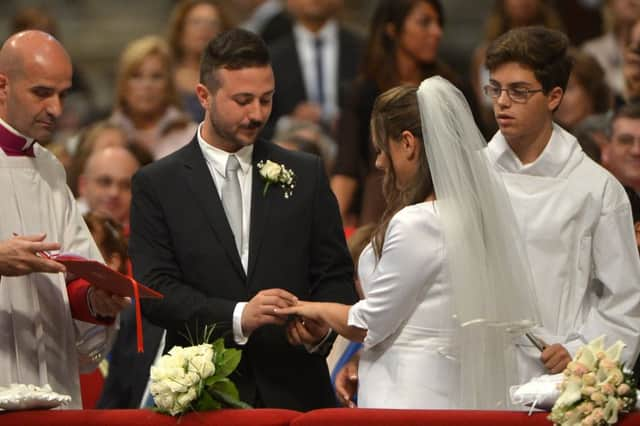Peter Magee: Marriage reforms to mend broken hearts


In a recent document on marriage, Pope Francis made a number of changes to the way the Church deals with annulments. Importantly, he reaffirmed traditional teaching on the “indissolubility of marriage”, while reaching out to many Catholics alienated from the Church because of broken marriages, which can be proven to have been invalid from the start.
The changes are intended primarily to shorten the duration of the nullity process and come in to effect from 8 December. To understand them, it is necessary to understand what the church means by marriage. A number of ingredients make up a Christian marriage. First, it is a covenant, between a man and a woman. It is also permanent and exclusive and its goal is the mutual welfare of the spouses as well as openness to the procreation, welfare, and education of children.
Advertisement
Hide AdAdvertisement
Hide AdWhen both husband and wife are baptised Christians, this natural marriage takes on the element of sacramentality, it becomes a visible sign of God’s love in the world. Marriage comes into being through lawfully manifested consent. When two people give themselves to one another in order to create a partnership of life and love (marriage), and they do so in a manner recognised by the community, they marry.
For two unbaptised people, this can be in front of a justice of the peace and in the middle of a field. For a baptised Christian, this can be wherever their faith community recognises the marriage. When at least one of the parties is Catholic, the Church requires the couple to express their desire to give themselves in marriage before a priest, deacon, or designated minister, with two witnesses. We call this the canonical form of marriage.
If a Catholic desires to enter marriage with a non-Catholic, a dispensation may be granted, allowing the parties to exchange their consent in another manner. The Church also teaches that marriage is permanent and cannot be dissolved so long as both parties remain alive. A Catholic annulment, known as a declaration of nullity or invalidity, is a statement of fact by the Catholic Church. Where, after carefully examining the couple’s broken relationship, the Church states that a valid marriage, as the Church defines marriage, never existed. It is not “Catholic divorce,” as some have called it. Divorce looks at the moment the relationship breaks down and says, “A marriage existed, and now we are ending it.” The annulment process says, “From the very beginning, something was lacking that was necessary for this relationship to be called a marriage.”
Quite often, what was lacking at the time was one of the essential elements or properties of marriage noted above. The Church takes cognisance of the civil legal realities of marriage, the annulment process mostly looks at cases in which one or both parties had a deficient consent at the moment of the marriage itself.
Sometimes, non-Catholics who plan to marry a Catholic, may be asked to go through the annulment process, even when neither person from the first union is Catholic. This is because the Church presumes the validity of any marriage between two people who are free to marry, and are not Catholic, at the time of their wedding.
The changes introduced by Pope Francis are designed to remove as much delay from the process as possible so that people are not living in uncertainty about their state before God and the Church. Some structural changes to the process will achieve this. The abolition of the need for two courts to examine a case before a marriage can be declared null, means that the decision of one court will now be enough, provided neither party opposes the decision.
This does not stop any party from exercising the right of appeal to a higher court should he/she so wish. A new “briefer process” has been introduced for cases which meet certain criteria: for example, both parties to the marriage ask for the annulment and can produce irrefutable proofs of fact of that nullity.
If all the conditions are in place, the diocesan Bishop, or his delegate, can declare the marriage null within 30 days. Pope Francis is trying to help the Church reach out to many Catholics estranged from the Church. By putting Bishops back at the centre of the administration of justice in the diocese, he is also trying to implement further the vision of “collegiality” so strongly emphasised at the Second Vatican Council.
• Mgr Peter Magee PhB STL JCD is the Officialis of the Scottish Catholic Inter-Diocesan Tribunal